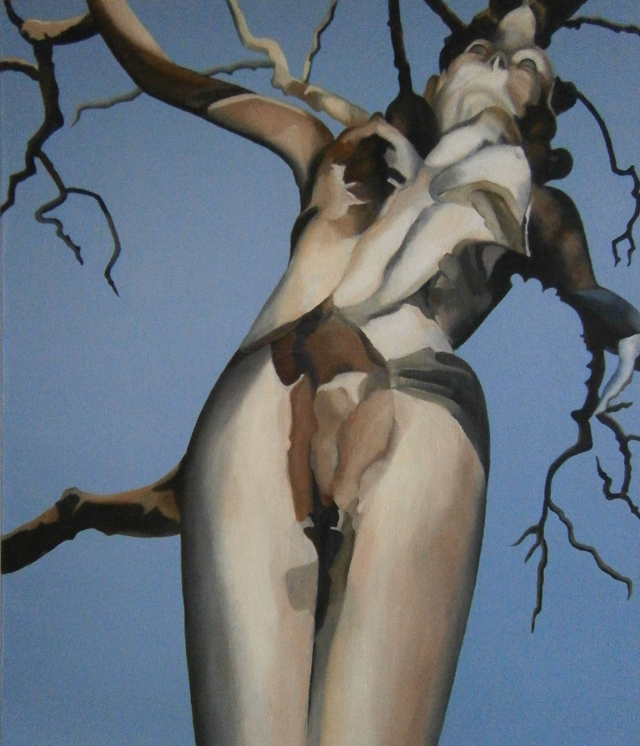
Mary Hrbacek: The Painted Veil That Those Who Live Call Life
Paris Koh Fine Arts, NYC
May 3, 2017 - May 13, 2017
Ms. Hrbacek has put together an important array of acrylic paintings for her show The Painted Veil That Those Who Live Call Life at Paris Koh Fine Arts in New York City. These works advance the traditional representation of the natural world into an aesthetic statement about the unity of human beings and the environment, while testifying to the artist’s growing assurance in the rendition of her trademark human-tree amalgams. Two related trends stand out: the emphasis on subtle yet discernible anatomy and the emergence of ambiguous images with echoes of human bits.
In her hybrid tree creations Hrbacek fuses male and female traits, which stretch the boundaries of conventional thought about nature, to forge images imbued with a mysterious aura of optimism that encourages viewer engagement and conjecture on the fantasy realm that extends beyond ordinary experience. There are no images of explosions or shootings on view; here the drama unfolds in dynamic juxtapositions of sophisticated shades of warm and cool tones and colors combined with an array of various intricate shapes and forms.
Many of the paintings blend a high level of abstraction with a vestige of realism and reality, fusing the human and tree to disclose mere glimpses of a figure.
The first work encountered by the gallery visitor illustrates some of the key principles driving Hrbacek's art.What’s new and noteworthy is a sharpened detailing -- a refinement that in conjunction with a modification of the work's background casts its subject into high relief. The result is a compelling experience as the viewer is drawn into an intimate engagement with a startling hybrid of woman and plane tree entitled Tree Woman. Of note here is Hrbacek’s presentation of her subject, a large acrylic on linen painting that treats the viewer to a great human-like trunk, inspired by an old growth tree she discovered in Central Park, New York City. As is the case with all the artist’s works, the background is unencumbered by distracting competition from other rendered objects. The flat appearance of the color actually brings the pieces into the realm of 21st century art by merging two ways of painting, hardedge abstraction and landscape into one format. The acrylic sports a pale blue background, which accentuates the emotionally charged sense of individuality and authority that emanates from this majestic quasi-figurative subject. Another recent work exhibiting the artist’s increasing complexity is Bonsai Blisswhich expresses a free, funky vibe in which the artist takes the top branches into a gnarly network of shapes and colors, invigorated by contrast with the swirling motion of the trunk.
Peter Wohleben's bestselling new book, The Hidden Life of Trees, discloses fresh new data on advanced modes of communication among trees. In Bonsai Bliss, Hrbacek highlights the intertwining maze of branches that evoke the complexities of web communication systems. In the painting Woman Withheld the artist accentuates an intense body language of contorted gestures that elicits a tragic mournfulness. The work entitled Apparition (image at top) displays a "skull" that appears to be signaling to the viewer.
While all the paintings in this show interpret trees in a range of identifiable forms, they are not figurative in the sense of a provision of mirror-like images. By incorporating elements of abstraction, they might best be described as representational. The artist does favor a smooth surface appearance, eschewing painterly brushstrokes that she finds unnecessary. This inclination reflects not only the resistant nature of acrylic to the brush but also the influence of the Renaissance masters for whom she holds a special regard. Because these works recognize not only the forms shared by the species but also their kindred spirits, there is a metaphysics at play that finds its source in the mythological foundations of Rubens, a confessed influence.
Hrbacek is not entirely alone in her devotion to the rendition of trees. One thinks of the arboreal aluminum impressions of Robert Lobe, the employment of trees as sculptural material by Giuseppe Penone, who "excavates a massive tree's early form" in his 2012 exhibition (Wikepedia), and the immense steel tree sculptures of Ai Weiwei on view in New York City in 2017. What is different here is an artistic concern with an arboreal-human hybrid.
Hrbacek's work provides a combination of close observation, abstraction, and technical skill (there's a wonderful surface to her paintings), which makes them emotionally powerful, intellectually pleasing and thought provoking. Ever the contrarian and independent thinker, the artist sticks to her trademark aesthetic, a topic close to her heart, which she originated while living in Sweden as a girl, in a Scandinavian culture that reveres nature and being outdoors. With a great level of refinement she continues to inject some happy invigoration into the 21st century landscape genre. - Walter Idlewild
Mr. Idlewild writes on the humanities at LanguageAndPhilosophy.com
